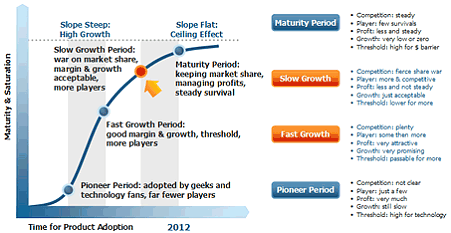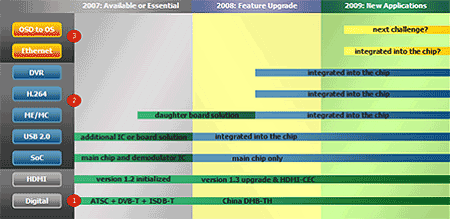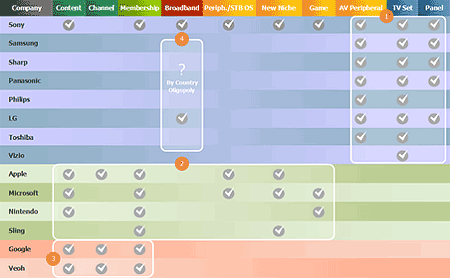
|
|
 |

|


|
Extended Capabilities Essential for
Continued TV Market Growth  Calvin Hsieh
Calvin HsiehAugust 28, 2008 DisplaySearch The TV market continues to boom in 2008, driven by falling TV prices, the DTV transition and the demand for higher resolution. Despite this, DisplaySearch's market research shows that the growth of the TV market will peak between 2009 and 2011. Thereafter, growth will be limited without the development of new, enhanced features for TVs, such as higher resolution, expanded broadband infrastructure, internet connectivity, versatile applications and interactive capabilities to meet the needs of the connected digital home of the future where PC and TV are synonymous. As a consumer electronics product, the TV's importance in the home is ranked high. Consumers may have two or more TV sets at home, but it's rare to have more than one washing machine or refrigerator. Since 2000, flat panel TVs and the digital signal evolution have made existing TV specifications obsolete, and the market has been stimulated with amazing growth. TV brands, as well as the entire TV supply chain, have prospered, including panel makers, materials, OEM, IC and components. Despite this, in studying the growth trend, DisplaySearch found the TV market will reach its growth ceiling around 2012, and in developed countries, it will be in 2009-2010. Based on this forecast, it becomes increasingly important to determine what benefits and advantages are most appealing to consumers to ensure continued TV growth and encourage them to purchase or change TVs to drive new stimulus again.  Figure 1 - Product Life Cycle The maturing market with lower growth rates does not mean that the TV game is ending: it's only just begun. The TV industry today is placing emphasis on Video Processing; but soon it will shift to a greater focus on Networking and Communications. Major TV brands have already announced cooperation with content providers like Google or USA Today. Whether it's for internet video (such as the Sony Bravia Internet Video Link) or web surfing, today's TV has certainly gone beyond the traditional critical role of simply receiving broadcasting. As a result of this evolving role of the TV, TV IC suppliers are working to make TVs more powerful to meet the requirements necessary for the "new TV". In reviewing mainstream specifications in 2008, the first trend is a single chip with many features integrated into one single IC. Demodulator, MPEG-2, de-interlacing, scaling and video processing are now combined. Furthermore, USB 2.0, DVR, HDMI 1.3 and H.264 will be integrated very soon to allow connections to content beyond traditional broadcasting. Picture quality will be enhanced, too. ME/MC (motion estimation and compensation), double frame rate (100/120 Hz) and FHD higher resolution have been introduced to create premiums in the retail market. Key IC suppliers have already developed their 2009 Ethernet support roadmaps to provide TVs with internet access. This feature, combined with high resolution and a broadband environment, will drive availability of even more content from the internet versus conventional broadcasting through a tuner.  Figure 2 - TV IC Features and Roadmap For TV IC suppliers and brands, it looks like a new game is beginning, but the players seem very different. DisplaySearch categorized the core components of the TV industry into four groups for its analysis:
 Figure 3 - Four Groups of Players in the Future of TV These players maintained leadership in their respective territories before, but the evolution of the TV creates a blurry line in recognizing who is a competitor versus who is a partner. For TV brands, their business model now is to maximize the market share for TV sets; products, channels and marketing are what concern them. But what about the next step? Could TV sets someday be sold under a business model similar to mobile phones with service providers and customization? In addition to the evolution of TV, there are other key issues the TV supply chain faces today:
DisplaySearch will examine TV evolution at its 6th Annual HDTV Conference, to be held September 15-17 in Los Angeles, Calif. The conference will feature sessions on some of the industry's most pressing topics such as such the connected television, "green" TVs, the future of packaged media, replacing analog and the retail channel, the digital TV transition and more. For more information or to register for the HDTV Conference, visit: www.displaysearch.com/hdtv. |
Bookmark:
![]() del.icio.us
del.icio.us
![]() Reddit
Reddit
![]() Google
Google
| Send this Page | Print this Page | Report Errors |

